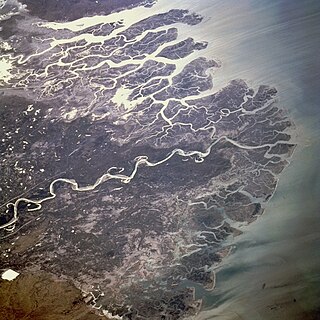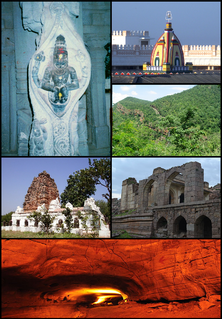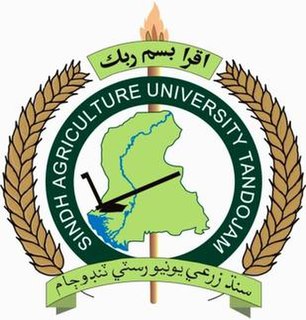
The Buckingham Canal is a 796 kilometres (494.6 mi) long fresh water navigation canal, that parallels the Coromandel Coast of South India from Kakinada City in the East Godavari district of Andhra Pradesh to Viluppuram District in Tamil Nadu. The canal connects most of the natural backwaters along the coast to Chennai (Madras) port.

Water reclamation is the process of converting municipal wastewater (sewage) or industrial wastewater into water that can be reused for a variety of purposes. Types of reuse include: urban reuse, agricultural reuse (irrigation), environmental reuse, industrial reuse, planned potable reuse, de facto wastewater reuse. For example, reuse may include irrigation of gardens and agricultural fields or replenishing surface water and groundwater. Reused water may also be directed toward fulfilling certain needs in residences, businesses, and industry, and could even be treated to reach drinking water standards. Treated municipal wastewater reuse for irrigation is a long-established practice, especially in arid countries. Reusing wastewater as part of sustainable water management allows water to remain as an alternative water source for human activities. This can reduce scarcity and alleviate pressures on groundwater and other natural water bodies.

Hyderabad District ,pronunciation (help·info) is a district of Sindh, Pakistan. Its capital is the city of Hyderabad. The district is the second most urbanized in Sindh, after Karachi, with 80% of its residents live in urban areas.

Musi River or Muchukunda River or Musinuru or moosa River is a tributary of the Krishna River in the Deccan Plateau flowing through Telangana state in India. Hyderabad stands on the banks of Muchukunda River or Musi river, which divides the historic old city and the new city. Himayat Sagar and Osman Sagar are dams built on it which used to act as source of water for Hyderabad. The river was known as Nerva during Qutub Shahi period. The river originates in Ananthagiri Hills near Vikarabad. It generally flows in easterly direction, turning South at Chittaloor. It flows into the Krishna River at Vadapally, near Miryalaguda in Nalgonda district.

Parcham was the name of one of the factions of the People's Democratic Party of Afghanistan, formed in 1967 following its split and led for most of its history by Babrak Karmal and Mohammed Najibullah. The basic ideology of the Parchamites was one of a gradual move towards Islamic socialism in Afghanistan. The Parcham faction supported this idea because they felt that Afghanistan was not industrialized enough to undergo a true proletarian revolution as called for in the Communist Manifesto.

The Indus River Delta, forms where the Indus River flows into the Arabian Sea, mostly in the southern Sindh province of Pakistan with a small portion in the Kutch Region of the western tip of India. The delta covers an area of about 41,440 km2, and is approximately 210 km (130 mi) across where it meets the sea. The active part of the delta is 6,000 km2 in area (2,300 sq mi). The climate is arid, the region only receives between 25 and 50 centimetres of rainfall in a normal year. The delta is home to the largest arid mangrove forests in the world, as well as many birds, fish and the Indus dolphin.

Sukkur Barrage is a barrage on the River Indus near the city of Sukkur in the Sindh province of Pakistan. The barrage was built during the British Raj from 1923 to 1932 and was named Lloyd Barrage. The Sukkur Barrage, is the pride of Pakistan's irrigation system as it is the largest single irrigation network of its kind in the world. It irrigates from Sukkur district in the north, to Mirpurkhas/Tharparkar and Hyderabad districts in the south of Sindh, almost all parts of the province. It is situated about 500 kilometres northeast of Karachi, 5 kilometres below the railway bridge, or the Sukkur Gorge. The introduction of barrage-controlled irrigation system resulted in more timely water supplies for the existing cultivated areas of Sindh province of Pakistan.

Kurnool district is one of the four districts in the Rayalaseema region of the Indian state of Andhra Pradesh. It is located in the North western part of the state and is bounded by Mahabubnagar district of Telangana in the north, Raichur district of Karnataka in the northwest, Bellary district of Karnataka in the west, Anantapur district in the south, Kadapa district in the south east and Prakasam district in the east. The city of Kurnool is the headquarters of the district. It has a population of 4,053,463 of which 28.35% were urban as of 2011. The district is the second largest by area and seventh largest by population in the state.
The Kalabagh Dam is a proposed hydroelectric dam on the Indus River at Kalabagh in the Mianwali District, Punjab, Pakistan, which has been intensely debated along ethnic and regional lines for over 40 years.

Mehran University of Engineering & Technology is a public research university located in Jamshoro, Sindh, Pakistan focused on STEM education.

Sindh Agriculture University, is situated in Tando Jam town of Hyderabad, on Hyderabad-Mirpurkhas highway and is about 200 km (120 mi) from Karachi airport linked with super highway to Hyderabad. Sindh Agriculture University is ranked 3rd best university in Agriculture by the Higher Education Commission.

The Badin District is a district in the Sindh province of Pakistan. The total area of the district is 6,726 square kilometers. Headquartered at the city of Badin, the district is situated between 24°-5` to 25°-25` north latitude and 68 21’ to 69 20’ east longitude and is bounded on the north by the Tando Allahyar District, Northwest by Hyderabad District, on the east by Mirpur Khas and Tharparkar districts, on the south by the Kutch district of India, and on the west by Sujawal and Tando Muhammad Khan District.

Tando Allahyar District is a district in the province of Sindh in Pakistan. Prior to becoming a separate district, it was part of Hyderabad District.

Tando Muhammad Khan District is a district in the southern part of Sindh province in Pakistan. In north of the district, Hyderabad and Tando Allahyar districts are located; Badin district lies on south and east; and West boundary is shared with Sujawal District. The Indus River flows through Northwest. Tando Muhammad Khan district comprises the three talukas of Tando Muhammad Khan, Bulri Shah Karim and Tando Ghulam Hyder.

Sewage treatment is a type of wastewater treatment which aims to remove contaminants from sewage to produce an effluent that is suitable for discharge to the surrounding environment or an intended reuse application, thereby preventing water pollution from raw sewage discharges. Sewage contains wastewater from households and businesses and possibly pre-treated industrial wastewater. There are a high number of sewage treatment processes to choose from. These can range from decentralized systems to large centralized systems involving a network of pipes and pump stations which convey the sewage to a treatment plant. For cities that have a combined sewer, the sewers will also carry urban runoff (stormwater) to the sewage treatment plant. Sewage treatment often involves two main stages, called primary and secondary treatment, while advanced treatment also incorporates a tertiary treatment stage with polishing processes and nutrient removal. Secondary treatment can reduce organic matter from sewage, using aerobic or anaerobic biological processes.

Hyderabad City Tehsil is an administrative subdivision (tehsil) of Hyderabad District in the Sindh province of Pakistan. Hyderabad district is subdivided into 4 talukas, the Urban area around the capital Hyderabad is part of Hyderabad City Taluka.
Kot Aalam, Kot Almo or Kot Aalmoon is a small village in Taluka Sujawal, Thatta District, in the Pakistani state of Sindh, situated on the left bank of the Indus River. In 1858 it was district of Sindh province. It is situated 8 km north from Daro city. After the floods of August 2010 many Memon families have migrated to other cities of Sindh, Specially Karachi, Daro, Mirpur Bathoro, Thatta and Tandojam.

Hussainsagar Lake and Catchment Area Improvement Project is a project led by Hyderabad Metropolitan Development Authority to improve the quality of Hussain Sagar Lake (pictured) in Hyderabad, India.
Rainee Canal Project is located in Ghotki, Sukkur and Khairpur Districts of Sindh Province in Pakistan. It is a canal that starts from the left bank of Indus River at Guddu Barrage. The total length of the main canal is about 175 km and length of its distributaries will be around 686 km.
Left Bank Outfall Drain is a drainage canal in Pakistan. Built between 1987 and 1997 using funding from the World Bank, the canal collects saline water, industrial effluents and Indus river basin floodwater from more than two million hectares of land of Shaheed Benazirabad, Sanghar, Mirpurkhas and Badin districts located in Nara river basin into the Arabian Sea.















